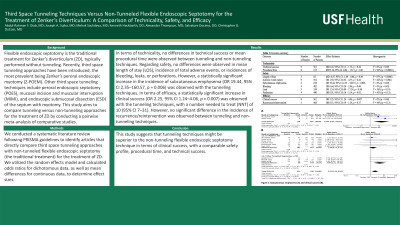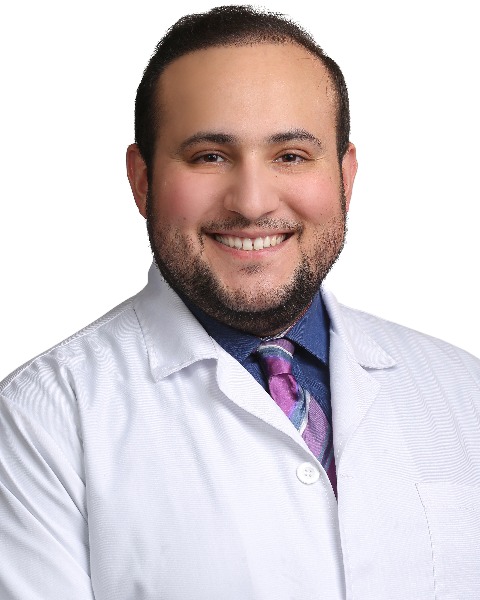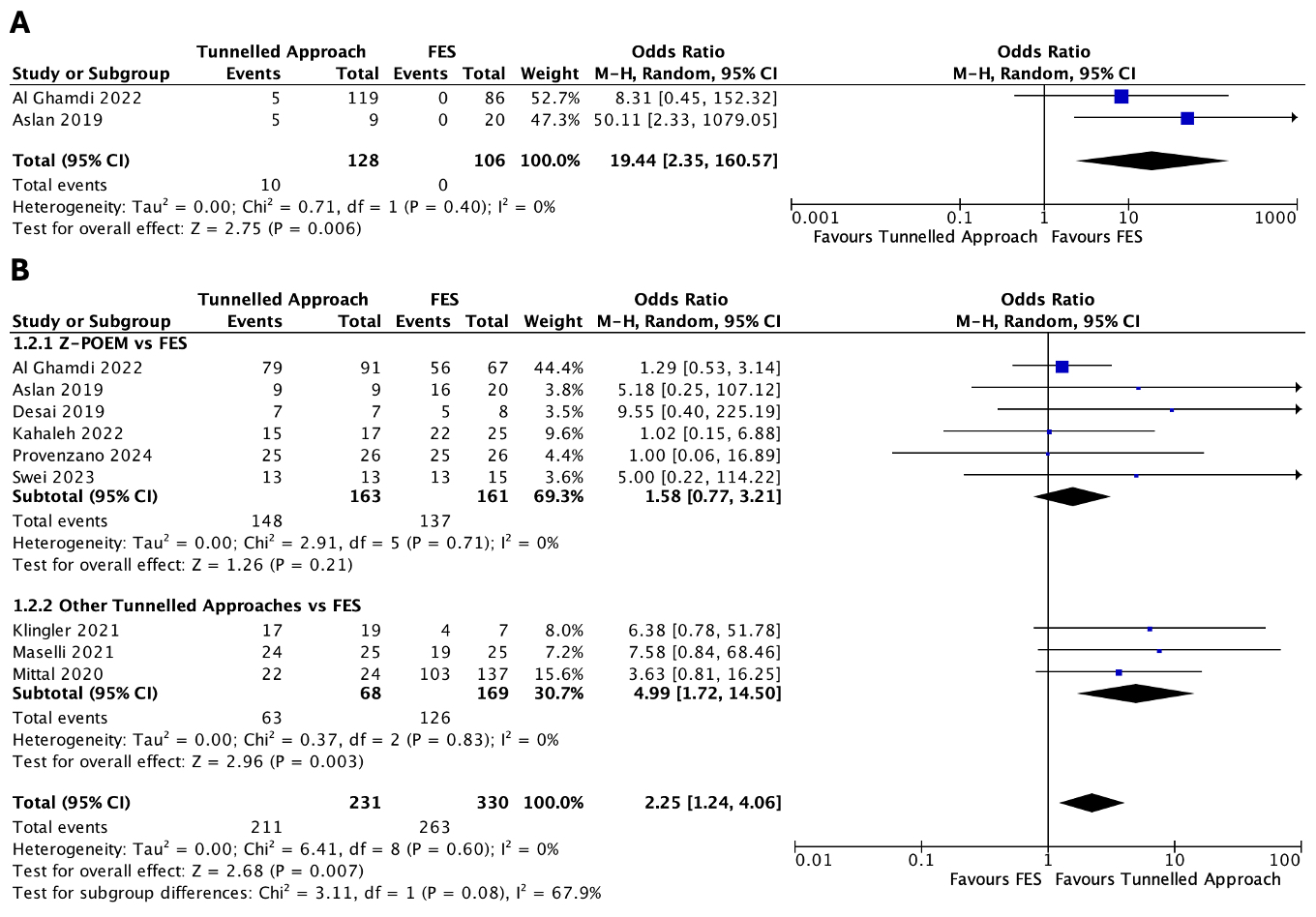Sunday Poster Session
Category: Interventional Endoscopy
P1029 - Third Space Tunneling Techniques Versus Non-Tunneled Flexible Endoscopic Septostomy for the Treatment of Zenker’s Diverticulum: A Comparison of Technicality, Safety, and Efficacy
Sunday, October 27, 2024
3:30 PM - 7:00 PM ET
Location: Exhibit Hall E

Has Audio

Abdul-Rahman F. Diab, MD
University of South Florida Morsani College of Medicine and University of Central Florida, HCA Healthcare GME
Ocala, FL
Presenting Author(s)
Abdul-Rahman F. Diab, MD1, Joseph A. Sujka, MD2, Mehak Sachdeva, MD3, Kenneth Hackbarth, DO3, Alexander Thompson, MD3, Salvatore Docimo, DO2, Christopher G. DuCoin, MD2
1University of South Florida Morsani College of Medicine and University of Central Florida, HCA Healthcare GME, Ocala, FL; 2University of South Florida Morsani College of Medicine, Tampa, FL; 3University of Central Florida, HCA Healthcare GME, Ocala, FL
Introduction: Flexible endoscopic septostomy is the traditional treatment for Zenker’s diverticulum (ZD), typically performed without tunneling. Recently, third space tunneling approaches have been introduced, the most prevalent being Zenker’s peroral endoscopic myotomy (Z-POEM). Other third space tunneling techniques include peroral endoscopic septectomy (POES), mucosal incision and muscular interruption (MIMI), and endoscopic submucosal dissection (ESD) of the septum with myotomy. This study aims to compare tunneling versus non-tunneling approaches for the treatment of ZD by conducting a pairwise meta-analysis of comparative studies.
Methods: We conducted a systematic literature review following PRISMA guidelines to identify articles that directly compare third space tunneling approaches with non-tunneled flexible endoscopic septostomy (the traditional treatment) for the treatment of ZD. We utilized the random effects model and calculated odds ratios for dichotomous data, as well as mean differences for continuous data, to determine effect sizes.
Results: In terms of technicality, no differences in technical success or mean procedural time were observed between tunneling and non-tunneling techniques. Regarding safety, no differences were observed in mean length of stay (LOS), incidence of total adverse events, or incidences of bleeding, leaks, or perforations. However, a statistically significant increase in the incidence of subcutaneous emphysema (OR 19.44, 95% CI 2.35–160.57, p = 0.006) was observed with the tunneling techniques. In terms of efficacy, a statistically significant increase in clinical success (OR 2.25, 95% CI 1.24–4.06, p = 0.007) was observed with the tunneling techniques, with a number needed to treat (NNT) of 10 (95% CI 7–31). However, no significant difference in the incidence of recurrence/reintervention was observed between tunneling and non-tunneling techniques.
Discussion: This study suggests that tunneling techniques might be superior to the non-tunneling flexible endoscopic septostomy technique in terms of clinical success, with a comparable safety profile, procedural time, and technical success.

Note: The table for this abstract can be viewed in the ePoster Gallery section of the ACG 2024 ePoster Site or in The American Journal of Gastroenterology's abstract supplement issue, both of which will be available starting October 27, 2024.
Disclosures:
Abdul-Rahman F. Diab, MD1, Joseph A. Sujka, MD2, Mehak Sachdeva, MD3, Kenneth Hackbarth, DO3, Alexander Thompson, MD3, Salvatore Docimo, DO2, Christopher G. DuCoin, MD2. P1029 - Third Space Tunneling Techniques Versus Non-Tunneled Flexible Endoscopic Septostomy for the Treatment of Zenker’s Diverticulum: A Comparison of Technicality, Safety, and Efficacy, ACG 2024 Annual Scientific Meeting Abstracts. Philadelphia, PA: American College of Gastroenterology.
1University of South Florida Morsani College of Medicine and University of Central Florida, HCA Healthcare GME, Ocala, FL; 2University of South Florida Morsani College of Medicine, Tampa, FL; 3University of Central Florida, HCA Healthcare GME, Ocala, FL
Introduction: Flexible endoscopic septostomy is the traditional treatment for Zenker’s diverticulum (ZD), typically performed without tunneling. Recently, third space tunneling approaches have been introduced, the most prevalent being Zenker’s peroral endoscopic myotomy (Z-POEM). Other third space tunneling techniques include peroral endoscopic septectomy (POES), mucosal incision and muscular interruption (MIMI), and endoscopic submucosal dissection (ESD) of the septum with myotomy. This study aims to compare tunneling versus non-tunneling approaches for the treatment of ZD by conducting a pairwise meta-analysis of comparative studies.
Methods: We conducted a systematic literature review following PRISMA guidelines to identify articles that directly compare third space tunneling approaches with non-tunneled flexible endoscopic septostomy (the traditional treatment) for the treatment of ZD. We utilized the random effects model and calculated odds ratios for dichotomous data, as well as mean differences for continuous data, to determine effect sizes.
Results: In terms of technicality, no differences in technical success or mean procedural time were observed between tunneling and non-tunneling techniques. Regarding safety, no differences were observed in mean length of stay (LOS), incidence of total adverse events, or incidences of bleeding, leaks, or perforations. However, a statistically significant increase in the incidence of subcutaneous emphysema (OR 19.44, 95% CI 2.35–160.57, p = 0.006) was observed with the tunneling techniques. In terms of efficacy, a statistically significant increase in clinical success (OR 2.25, 95% CI 1.24–4.06, p = 0.007) was observed with the tunneling techniques, with a number needed to treat (NNT) of 10 (95% CI 7–31). However, no significant difference in the incidence of recurrence/reintervention was observed between tunneling and non-tunneling techniques.
Discussion: This study suggests that tunneling techniques might be superior to the non-tunneling flexible endoscopic septostomy technique in terms of clinical success, with a comparable safety profile, procedural time, and technical success.

Figure: Subcutaneous emphysema (A) and clinical success (B).
Note: The table for this abstract can be viewed in the ePoster Gallery section of the ACG 2024 ePoster Site or in The American Journal of Gastroenterology's abstract supplement issue, both of which will be available starting October 27, 2024.
Disclosures:
Abdul-Rahman Diab indicated no relevant financial relationships.
Joseph Sujka indicated no relevant financial relationships.
Mehak Sachdeva indicated no relevant financial relationships.
Kenneth Hackbarth indicated no relevant financial relationships.
Alexander Thompson indicated no relevant financial relationships.
Salvatore Docimo indicated no relevant financial relationships.
Christopher DuCoin indicated no relevant financial relationships.
Abdul-Rahman F. Diab, MD1, Joseph A. Sujka, MD2, Mehak Sachdeva, MD3, Kenneth Hackbarth, DO3, Alexander Thompson, MD3, Salvatore Docimo, DO2, Christopher G. DuCoin, MD2. P1029 - Third Space Tunneling Techniques Versus Non-Tunneled Flexible Endoscopic Septostomy for the Treatment of Zenker’s Diverticulum: A Comparison of Technicality, Safety, and Efficacy, ACG 2024 Annual Scientific Meeting Abstracts. Philadelphia, PA: American College of Gastroenterology.
